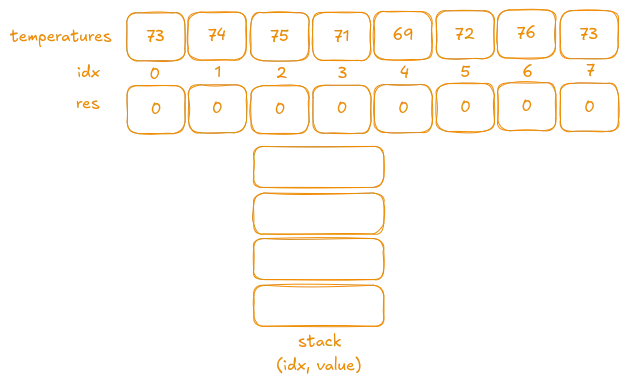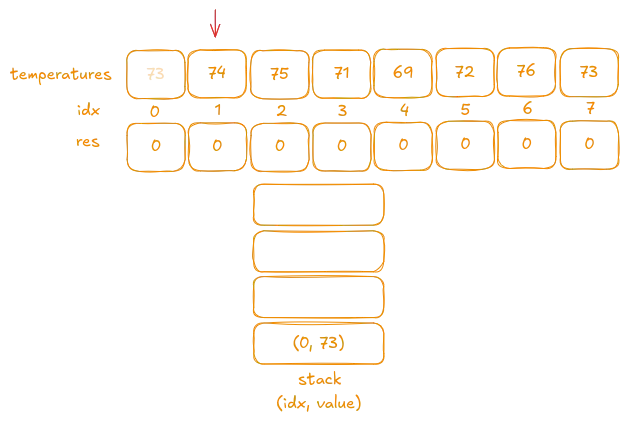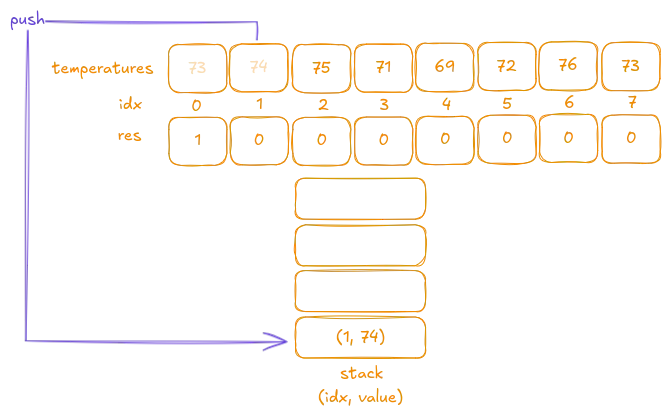739. Daily Temperatures
Description
Given an array of integers temperatures represents the daily temperatures, return an array answer such that answer[i] is the number of days you have to wait after the ith day to get a warmer temperature. If there is no future day for which this is possible, keep answer[i] == 0 instead.
Examples
-
Example 1:
- Input:
temperatures = [73,74,75,71,69,72,76,73] - Output:
[1,1,4,2,1,1,0,0]
- Input:
-
Example 2:
- Input:
temperatures = [30,40,50,60] - Output:
[1,1,1,0]
- Input:
-
Example 3:
- Input:
temperatures = [30,60,90] - Output:
[1,1,0]
- Input:
Constraints
- 1 <= temperatures.length <= 105
30 <= temperatures[i] <= 100
Test
#[cfg(test)]mod tests { use super::*;
#[test] fn test_example1() { let temperatures = vec![73, 74, 75, 71, 69, 72, 76, 73]; let result = daily_temperatures(temperatures); let expected = vec![1, 1, 4, 2, 1, 1, 0, 0]; assert_eq!(result, expected); }
#[test] fn test_example2() { let temperatures = vec![30, 40, 50, 60]; let result = daily_temperatures(temperatures); let expected = vec![1, 1, 1, 0]; assert_eq!(result, expected); }
#[test] fn test_example3() { let temperatures = vec![30, 60, 90]; let result = daily_temperatures(temperatures); let expected = vec![1, 1, 0]; assert_eq!(result, expected); }
#[test] fn test_single_element() { let temperatures = vec![50]; let result = daily_temperatures(temperatures); let expected = vec![0]; assert_eq!(result, expected); }
#[test] fn test_descending_order() { let temperatures = vec![100, 90, 80, 70]; let result = daily_temperatures(temperatures); let expected = vec![0, 0, 0, 0]; assert_eq!(result, expected); }
#[test] fn test_all_same() { let temperatures = vec![50, 50, 50, 50]; let result = daily_temperatures(temperatures); let expected = vec![0, 0, 0, 0]; assert_eq!(result, expected); }}Prototype
pub fn daily_temperatures(temperatures: Vec<i32>) -> Vec<i32> { todo!()}Solutions
Brute Force
The brute force solution is, as always, not very efficient—one test may even fail with a timeout. We can “trick” this test because it contains many duplicates, but let’s not spend too much time on that. The idea is simple: we use nested loops to iterate until we find a number greater than the current one.
pub fn daily_temperatures(temperatures: Vec<i32>) -> Vec<i32> { let mut res = vec![0; temperatures.len()]; for (i, &num) in temperatures.iter().enumerate() { for y in i..temperatures.len() { if temperatures[y] > num { res[i] = (y - i) as i32; break; } } } res}- Time Complexity: O(n²)
- Space Complexity: O(n)
Stack
The stack solution is straightforward to implement. Let’s start with an example:
- Input:
temperatures = [73,74,75,71,69,72,76,73] - Output:
[1,1,4,2,1,1,0,0]

First, we initialize the res vector with all zeroes as a default value when no higher temperature is found. With a stack, we push a tuple (index, temperature) onto it, and whenever we encounter a temperature greater than the one at the top of the stack, we pop from the stack.
There are a couple of challenges to note:
-
Index Difference:
Each value in the output represents the difference in indexes between the current temperature and the next higher temperature. Therefore, we need to keep track of the indexes by using a tuple(index, value). -
Multiple Elements on the Stack:
In some cases, there may be multiple elements on the stack waiting for a higher temperature. Our solution should handle these scenarios appropriately.
Let’s walk through the iteration:
-
Iteration 1:
The first value is73. Since the stack is empty, we push(0, 73)onto the stack.
-
Iteration 2:
The next value is74, which is greater than the temperature at the top of the stack (73).
We pop the tuple
(0, 73)from the stack. The difference in indexes is1 - 0 = 1, so we setres[0]to1. And then we push the currenttemperature[i]onto stack to find a higher value for it as well.
-
Iteration 3:
The next value is75, which is greater than the current stack top74. We follow the same steps as before: pop the top element, calculate the difference in indexes, and update the result.

-
Iteration 4 & 5:
I’ll combine the next two iterations because the same action is performed in both. Consider the next two values:
As shown, the next value
71is less than the current stack top75, so we push it onto the stack. Then, the following value69is less than the new stack top71, so it is also pushed onto the stack.
FYI: On the stack, we now see (from top to bottom):
69, 71, 75. This structure is called a Monotonic Decreasing Stack. -
Iteration 6:
The next value is72, which is greater than the top of the stack69. We pop the tuple(4, 69). The current index is5, so we updateres[4]to5 - 4.
Since
69has been popped, the new stack top is71, and72is greater than71as well. To handle temperatures that are higher after more than one day, we continue to pop elements while the current value exceeds the stack top.Next, we pop the tuple
(3, 71). The current index is still5, so we updateres[3]to5 - 3.
We can handle now all cases.
pub fn daily_temperatures(temperatures: Vec<i32>) -> Vec<i32> { let mut res = vec![0; temperatures.len()]; let mut stack: Vec<(usize, i32)> = vec![];
for (i, cur_temp) in temperatures.into_iter().enumerate() { while let Some(&(top_stack_idx, top_stack_val)) = stack.last() { if cur_temp > top_stack_val { res[top_stack_idx] = (i - top_stack_idx) as i32; stack.pop(); } else { break; } } stack.push((i, cur_temp)) } res}- Time Complexity: O(n)
- Space Complexity: O(n)